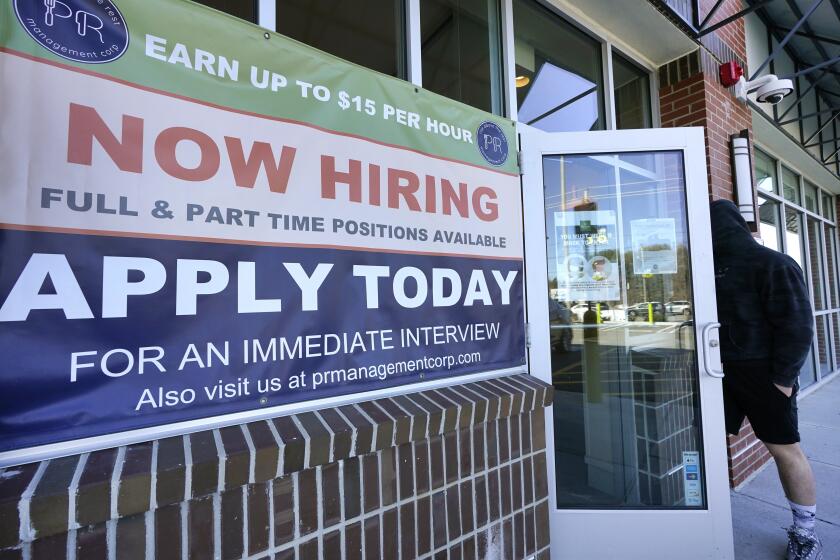Inflation is back. How high and how long will prices go up?

- Share via
WASHINGTON — Used car and truck prices jumped 10% between March and April, the largest increase in nearly 70 years. Airfares and hotel rates rose about as much. And consumers paid significantly more for computers, shoes, furniture, sporting equipment and a host of other goods and services.
Inflation is back, after decades during which consumer prices rose hardly at all and economists worried about the dangers of deflation and the economic stagnation it can bring.
The big question now is whether the current price surges are temporary or are warning signs of serious problems ahead.
One possibility is that the economy and the U.S. workforce, after being deeply shaken up by the COVID-19 pandemic, are experiencing the ups and downs of getting back to normal.
The other possibility, that the economic shocks of the pandemic have set off deep-seated inflationary forces, is far more serious. That would put pressure on the Federal Reserve to step on the economic brakes and President Biden to curb his spending plans even though unemployment remains high and thousands of businesses are still struggling to survive.
Most economists agree that inflation worries, at least for now, are overdone. That’s in part because the monthly reading of consumer prices is compared against last year’s level, when prices were unusually depressed because of the collapse in demand resulting from lockdowns and stay-at-home orders. Later months of year-over-year comparisons won’t have such big distorting effects.
Leo Feler, a UCLA economist who is preparing the inflation section of the Anderson Forecast, said prices for food consumed at home, which rose in April, should start to revert as people go out more. And as supply constraints and bottlenecks clear up, other inflationary pressures also will fade.
Employers added only 266,000 jobs in April, down from March and far short of expectations. That could give Biden’s stimulus spending plans a boost.
Still, some economists have been warning for some time about the risks of spiraling inflation, and those fears were heightened and sparked a second day of sell-offs on Wall Street after the government’s report Wednesday that consumer prices rose 4.2% in April from a year earlier.
That was the highest jump since September 2008 and well above what analysts were forecasting.
Economists say what happens with prices down the road will be determined by inflation expectations and the slack in the economy, in particular labor.
The upturn in prices may be a shock for a current generation that has known almost nothing in terms of meaningful inflation, with few exceptions such as occasional surges in gas and food prices.
“Not too many consumers think the latest bout of inflation is temporary. They see prices of everything from computer chips to chicken wings jumping,” said Sung Won Sohn, professor of finance and economics at Loyola Marymount University.
“Given the tightening labor market, labor costs, which account for at least two-thirds of the [consumer price index], will lift off, leading to higher wages and inflation expectations,” Sohn said.
What’s more, price increases are not easily lowered; they tend to stick. And last month, about 36% of small businesses surveyed by the National Federation of Independent Business indicated that they had raised selling prices, the highest share in 40 years.
Natasha Amott, who operates a kitchenware retail store in downtown Brooklyn called Whisk, said she had little choice but to raise prices, especially on steel products such as baking pans, cookie sheets and skewers. She said half of her 200 suppliers have announced price increases already or by summer, many of them 5% or more.
“Absolutely no way we can eat it all,” Amott said of the price increases, adding that she’s also paying more in freight costs. “For the vast majority of products, consumers will see a nickel here, a quarter there, sometimes it’s whole dollar increases.”
In recent weeks, Amott has been preparing her employees on how to respond to sticker-shock complaints.
The current trend is a stark change from the last decade when annual inflation ran below the Federal Reserve’s 2% target. Consumer prices rose just 1.25% last year as COVID-19 forced much of the economy into lockdown.
But this spring has brought a perfect storm for pressure on prices: a speedy economic recovery fueled by increased vaccinations, massive federal spending, a huge reservoir of savings, pent-up demand and largely unrelated shortages of semiconductors, lumber and other commodities.
On top of those pressures have come transportation delays and other supply chain bottlenecks. Used car prices, for example, have surged as a chip shortage has slowed production of new cars despite heavy demand from consumers. The blocked Suez Canal in March tied up millions of dollars in global trade.
A cargo ship has been wedged in the Suez Canal for two days, sealing off the waterway in a crisis that could have major consequences for global trade.
Wednesday’s data came on top of the surprising employment report Friday showing far lower job growth than expected, in part because businesses couldn’t fill open positions. If sustained, a worker shortage could lead to wage increases and a further boost to inflation.
Fed Vice Chair Richard Clarida, in a speech Wednesday, reiterated the central bank’s view that the higher inflation will prove to be “transitory” and that by next year it should return to the Fed’s 2% target or a little above, suggesting that policymakers were not wavering from their plan not to lift interest rates until after 2023.
Fed Chair Jerome H. Powell and his colleagues have pledged to maintain rock-bottom rates as they focus on reaching their goal of a full and broad recovery in employment. That is not likely until at least next year, and withdrawing monetary support too soon would damage the institution’s credibility.
But investors pushed 10-year bond yields sharply higher Wednesday, and rising long-term rates will increase the borrowing cost for mortgages and other loans, which could hurt the housing market and the broader economy.
At the same time, while rising prices generally will be felt especially hard by low-income households, moderately higher inflation may not be such a bad thing for many people and businesses.
For homeowners and others with fixed loans, higher inflation lowers their real cost of paying interest charges on their debt.
More inflation also could help wage earners to the extent that it gives companies more pricing power, conceivably allowing them to increase wages more easily; wage growth tends to track inflation. Today there are some signs that employers are boosting wages to meet rising demand and what many say is a lack of available workers.
For Biden, it could help spur growth if more people, seeing prices rising, unleash spending to avoid having to pay more later. Higher inflation will lower the real cost of paying the national debt, although the downside is that the government will almost certainly have to offer higher interest rates on new Treasury issues.
Longer range, UCLA’s Feler said, there’s good reason to think there won’t be an inflationary spiral like what the nation saw in the 1970s, as some have warned, because consumers today have more information and a lot more products to choose from and can easily make substitutions.
What’s more, Feler said the growth of so-called superstar companies such as giant online stores and discount warehouses — which have gained market share as many small businesses have shut down — could help to hold down inflation because they can pass to consumers savings from their greater efficiency and buying power over suppliers.
“The trick is that you need to have still very vigorous competition among these large superstar companies,” he said.
Other economists say that large companies, in a climate of greater market concentration, will find it easier to increase prices. Also, the rise of China as the world’s factory floor over the last 30 years helped keep prices down, but many companies are looking to remake supply chains for political and economic reasons, including risks of shock events such as the pandemic.
Michael Weber, an economist at the University of Chicago Booth School of Business, said inflation expectations may not be as well “anchored” as the Fed and others believe at the moment.
In his research, Weber found that consumers’ outlook on inflation is influenced predominantly by the things they buy most, such as milk. (The price of fresh whole milk was up 4.4% last month from a year earlier.)
“That could be really troublesome for monetary policy makers,” he said, “because their whole paradigm rests implicitly on inflation expectations being well anchored.”
More to Read
Get the L.A. Times Politics newsletter
Deeply reported insights into legislation, politics and policy from Sacramento, Washington and beyond. In your inbox twice per week.
You may occasionally receive promotional content from the Los Angeles Times.













